It is doubtful Paper Mulberry fruit is on sale anywhere. Oh, it might be found in some local farm market in remote China but even that is doubtful. Though tasty the fruit doesn’t travel well. From the tree to your mouth is about the most distance it can endure.
And perhaps I shouldn’t admit it but it took me many years to identify the Paper Mulberry. None of my botanical friends knew it though it’s found in about 40% of the United States. In the U.S. its range is from Illinois to Massachusetts, south to Florida and west to Texas. Apart from some loss of leaf in our moderate winters it really never changed much, or fruited. It was on my ignore/someday list. Then I happened to be in north Florida one year at the right time and the right place and saw orange pompoms on the tree. The rest was easy. The Paper Mulberry is actually native to temperate climates so I suspect it often doesn’t get chill hours to fruit, a necessity for some species particularly northern ones. Or, all the local trees might be male clones originally propagated for paper and cloth.
The trees puts on hundreds of pompom like fruit, some full some sparse. They are just starting to come into season. My video on them was shot in late June when the trees where very ladened. There is one local small tree, the Buttonbush, that looks vaguely similar but it has non-edible white pompoms. We are looking for a large tree with orange pompoms. The Paper Mulberry’s large leaves and distinctive bark make it easy to identify (one you know what it is!) To read more about the Paper Mulberry, go here.
Hackberry (or Sugarberry) trees are easy to overlook despite their large size. I think they also give credence to the thought that Native Americans managed their forests and didn’t just leave them to the wild ways of nature. By June every year Hackberries puts on a crop of pea-sized green fruits that by fall turn dark orange. The entire fruit is edible, seed and all, and they are indeed sweet. The tree is also very easy to identify. It has very distinctive warty bark without thorns, leaves with asymmetrical shoulders and three distinct veins on the back. As a species it also likes to grow near fresh water. So what’s the issue with the tree? It’s tall! Huge even. The fruit is high up. I think the natives trimmed select trees to keep them short and accessible. Otherwise there is a lot of work and danger in collecting hackberries for a snack. To read more about this often ignored tree click here.
They’ve been years in the making but my foraging videos that are on You Tube are now available in DVDs. They are the same videos you can watch for free on the Internet but some folks like to have their personal “hard” copy. There is a slight difference between the set and the Internet. Some of the earlier videos were slightly enhanced by several digital processes when made to fit the DVDs. The nine-volume set includes the first 135 videos (for less than $1 each.) And my FLIP video camera died so I’ll be making more videos (for volume 10) on a new camera. Should be fun. They’ve been on sale since the page went up Saturday and I am already busy filling orders. You can find the link for the DVDs on 1) EatTheWeeds home page, at 2) ForagingVideos.com or 3) click here.
Early on I developed two interests: One was foraging for wild plants. It assured me where ever I went I could find food. The other was watching clouds, one of the few things you can do on your back in public, preferably in a hammock with a cool drink. On a 24-hour basis you can predict the weather just as well as the weather bureau… which may or may not be saying much. By studying the sky you can get the forecast as right or wrong as the professionals.
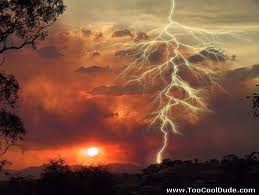 Because of geography this is the lightning capital of the United States, second in the world only after Rwanda in Central Africa which bests Central Florida by 2.5 times more strikes per year. Thunderstorms ferment in a very predictable pattern and one can watch their growth and life cycle. Plants are the same way. When you’re in a hammock all you have to do is look a little to the left, right or up to find a plant to study should the clouds blow away. Besides geography clouds and plants have one other thing in common: People ignore them.
Because of geography this is the lightning capital of the United States, second in the world only after Rwanda in Central Africa which bests Central Florida by 2.5 times more strikes per year. Thunderstorms ferment in a very predictable pattern and one can watch their growth and life cycle. Plants are the same way. When you’re in a hammock all you have to do is look a little to the left, right or up to find a plant to study should the clouds blow away. Besides geography clouds and plants have one other thing in common: People ignore them.
As little as 70 years ago, or if you like round numbers, 100 years ago, most humans on the earth watched the sky and plants intensely for survival, food, shelter, advanced warning, and contentment.
Until about World War II most people still lived an agrarian life, they were down on the farm. In the second half of the 1900s most people left the farm. By 2000 most people had left the earth for the Internet. Like books, radio and television before it, the Internet has removed us even more from the world around us.
 On one of my foraging videos a fellow left a comment that was so mangled I looked up his You Tube profile. In the previous 15 months he had watched 19,400 videos. That’s an average of 46 videos a day, an amazing amount of time on the Internet. If he also spent the American average of 34 hours a week watching TV there was little time left for sleeping and eating let alone relating to the external world or the people in it.
On one of my foraging videos a fellow left a comment that was so mangled I looked up his You Tube profile. In the previous 15 months he had watched 19,400 videos. That’s an average of 46 videos a day, an amazing amount of time on the Internet. If he also spent the American average of 34 hours a week watching TV there was little time left for sleeping and eating let alone relating to the external world or the people in it.
Not too long ago I had to do some research about the Internet and among the findings was those under 30 or so view the Internet as reality. They view life off the net as not reality. In a century we have gone from very attuned to the world around us to viewing it as not real. When one considers it is the world around us that keeps us alive in a variety of ways it is quite a significant thing to ignore.
Years ago I started my site and videos because some of my environmentalist friends could barely tell apples from oranges, especially if the packaging was the same. Recognizing a trash tree from a productive tree was an impossibility. They were committed environmentalists who knew little about the environment, real world. It was a political cause more than a persona appreciation. One sees that reflected in environmentalists who burn down businesses. Apparently that smoke and particulate matter doesn’t harm the environment. Then there’s the “management” of the environment. It can expresses itself in bizarre ways such as working hard to create a bike trail then spraying a 20-foot wide swath on each side to kill back the plants, a brown belt way rather than a green one. Recently local park officials killed off all the shore plants along a small lake because they thought it would look more aesthetically pleasing without the plants. Sometimes those in charge of an environment are as abusive to it as those they are supposedly protecting it from.
 To me the environment is intimate, personal. Can I eat that sow thistle or is the ground or water polluted? Am I downhill from the interstate or was this an old railroad bed? (Railroad land is among the most toxic of places to forage because a long history of using extremely potent chemicals.) It’s difficult to be intimate with something as expansive as global warming let alone make sense of its heated debate. But I do think just as humans have drifted away from being attuned to the world around them, environmentalists have drifted away from the environment; it’s a political cause not a personal commitment. And the problem with political causes is they are like wars. the only element you control is when you start them. Then they take on a life of their own and who knows where they will go or what you will end up with.
To me the environment is intimate, personal. Can I eat that sow thistle or is the ground or water polluted? Am I downhill from the interstate or was this an old railroad bed? (Railroad land is among the most toxic of places to forage because a long history of using extremely potent chemicals.) It’s difficult to be intimate with something as expansive as global warming let alone make sense of its heated debate. But I do think just as humans have drifted away from being attuned to the world around them, environmentalists have drifted away from the environment; it’s a political cause not a personal commitment. And the problem with political causes is they are like wars. the only element you control is when you start them. Then they take on a life of their own and who knows where they will go or what you will end up with.
Upcoming foraging classes: Saturday, June 29th, Dreher Park, 1310 Southern Blvd., West Palm Beach, FL., 33405. 9 .am. Sunday, June 30th, Maritime Hammock Sanctuary, 6200 S. Highway A1A, Melbourne Beach, FL 32951, 9 a.m.
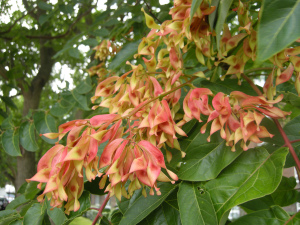
The Tree of Heaven, pest or profit? Photo by Davisla
What do you do about invasive species that are so invasive that you can’t get rid of them? It’s a problem in many areas and no easy solutions. One thing you can do is while trying to figure out ways to get rid of it is find ways to use it. In Pennsylvania they have a problem with the “Tree of Heaven” Ailanthus altissima. From China originally it came to the fledgling United States just about the time the victorious colonies were putting together the federal government, 1784 or so. It’s now found in most of North American except the high plains states and adjunct Canadian providences. As the link below shows it’s taking over forest land. Do you stand in front of the tide? Do you try to moderate it or just get out of the way? Any solution will take time. Meanwhile, however, use the species if possible. Use might mean manageable control.
Nowhere in the article linked here will you read that the tree makes a very unusual honey, green and brown, not good when young. But once aged it is amongst the best with an aroma of Muscat wine. What you also don’t read in the article, or from the mouth of the expert, is the tree makes good pulp wood (and paper.) Research shows the tree has anticancer, antimalarial, anti-inflammatory and amoebicidal qualities. It might also be a source of “natural” insecticides and herbicides. Invasive? Perhaps. But what it turns out to be is more a matte of attitude. Attitude can be the difference between trash and treasure.

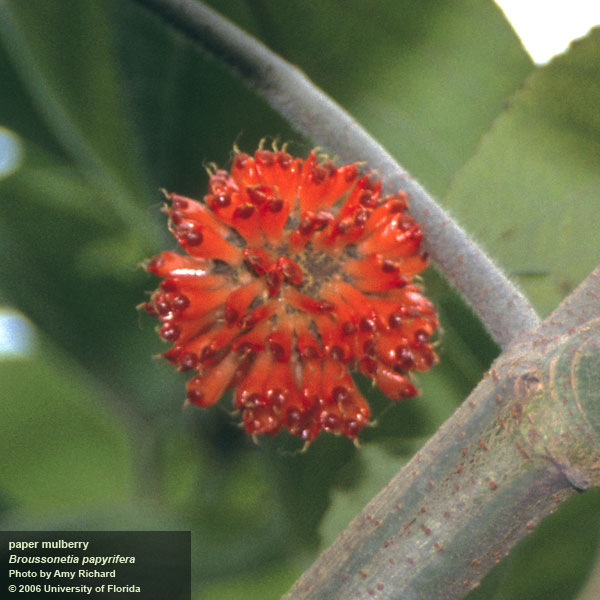
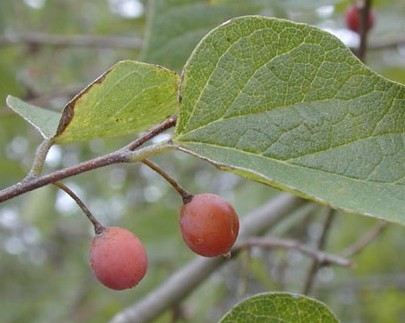

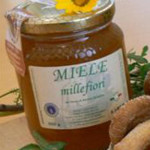

I have not been on your email list very long. I don’t know if you ever come to the Brooksville area for foraging classes. I love your site.
Amy
I do get to New Port Richey which isn’t far away and has the same plants.
I loved your comments on the internet becoming so many people’s reality. Sad but true. Some of us are old enough to still prefer fresh air and living things.
You also hit the nail on the head with environmentalists. If it’s their idea and suits their cause it doesn’t matter if it’s even logical or that it might be worse than what they are fighting. Crazy, arrogant people. I think ignoring nature’s unadulterated bounty is one of the greatest environmental crises of all.
I read your articles more for interest than actual practical application for a variety of reasons (it’s no longer easy for me to get around on uneven ground, and I don’t live in a moderate climate) but I’ll keep this newsletter for sure. Excellent points.
Thanks. I appreciate the feedback.
I have really been looking forward to getting your new Eat the Weeds DVD collection. I started to order, but my internet security soft wear on my computer, advised against it, because of a out of date security certificate, or something like that. It said it may be unsafe to give this site my credit card number. Is there another way to order, or let this site know that it needs to fix this out of date security certificate problem? Thank You.
Thanks for writing. I use pay pal and have not had any reports like than in the two years its been up. I will let my webmaster know.
Thank you for sharing your thoughts on clouds, plants, the Internet vs. reality, and environmentalists who focus on a political cause rather than a personal commitment. Well spoken!
Thank you so much for the labor of love blog/web page. I learn so much from your well documented and easy to understand discussions. I also appreciate very much the good point of possible worth of ‘invasive’ species. The carob tree has been declared invasive here in California and it has such a yummy fruit, is drought tolerant nitrogen fixer. They say it burns too well and it grows everywhere without any care.
I also want to mention that during our last move to Florida we were introduced to an herb called deer tongue which we found to be very effective in stopping the effects of fire ant bites! We also found it grows well here in California.
Excellent newsletter, as ever. I love the internet graphic, it’s tragically funny. I am going to get a life….. as soon as I log off.